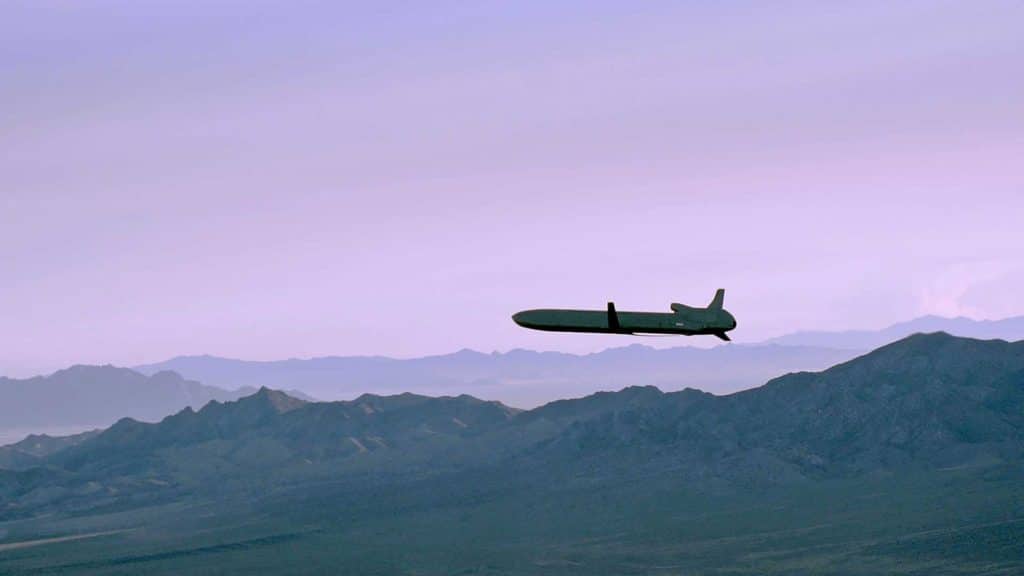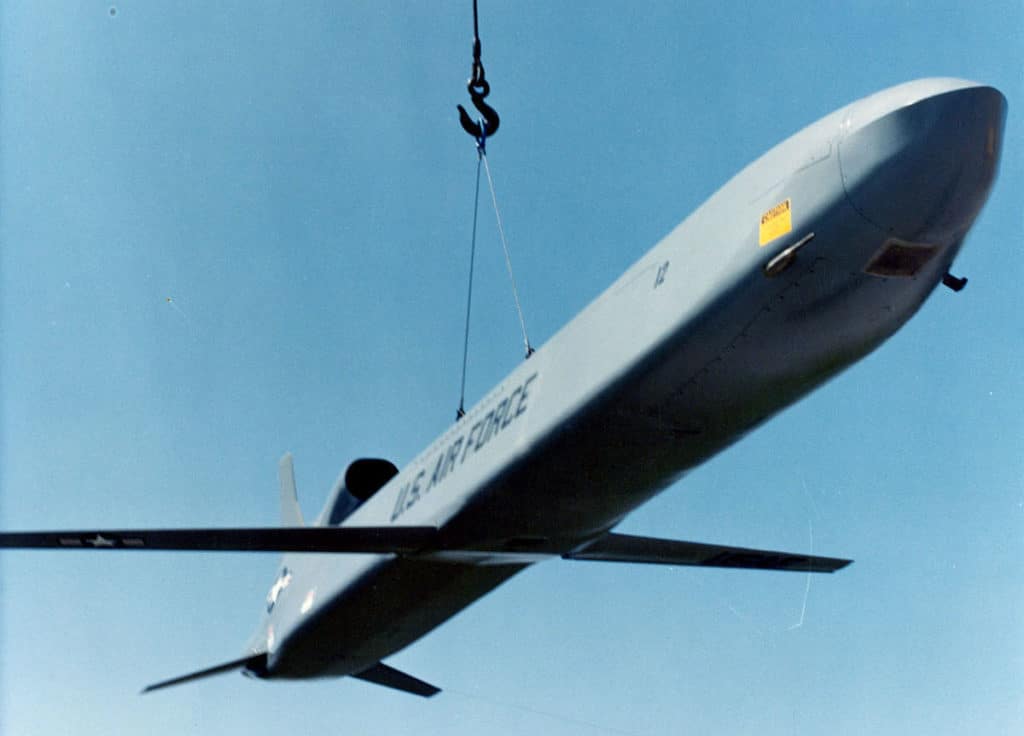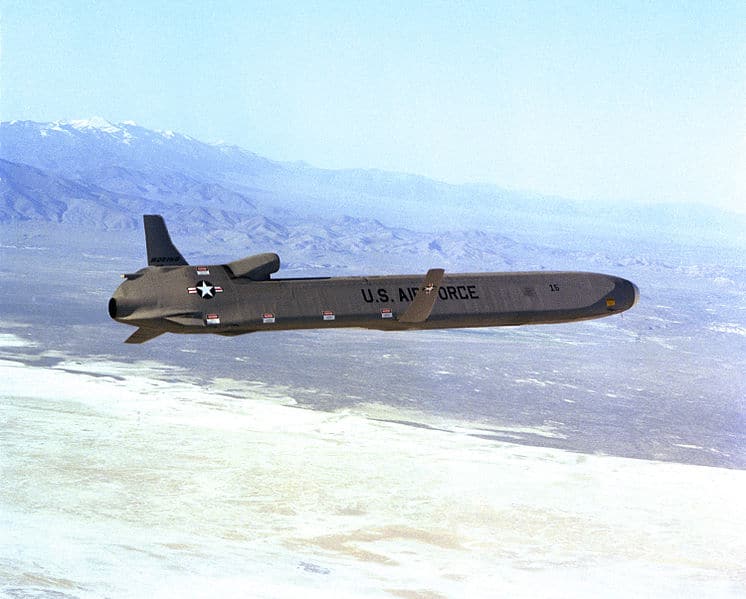The AGM-86 Air-Launched Cruise Missile (ALCM) is a long-range, air-launched standoff missile designed to give U.S. bombers the ability to launch their payload from outside the range of anti-aircraft weapons. It is a central element of the United States strategic bomber force.
ALCM at a Glance
- Originated From
- United States
- Class
- Subsonic Cruise Missile
- Possessed By
- United States
- Basing
- Air-launched
- Length
- 6.32 m
- Diameter
- 0.69 m
- Launch Weight
- 1,458 kg (AGM-86B), 1,750 kg (AGM-86C/Block 2), 1,950 kg (Block 1)
- Payload
- Single warhead
- Warhead
- 200 kT (AGM-86B), 1,360 kg HE (Block 1), 545 kg HE penetration (Block 2)
- Propulsion
- Turbofan
- Range
- 2,500 km (AGM-86B), 950 km (AGM-86C), 1320 km (AGM-86D)
- Status
- Operational
- In Service
- 1982-Present (AGM-86B) 1986-2019 (AGM-86C/D)

An AGM-86 ALCM in flight. Photo: U.S. Air Force 
An AGM-86B ALCM model on display. Photo: U.S. Air Force 
An AGM-86 ALCM in flight. Photo: U.S. Air Force
ALCM Development
The ALCM program began in the early 1970s, designed to give U.S. bombers the ability to launch their payload from outside the range of Soviet anti-aircraft weapons. The series includes several variants to allow for different payloads or ranges. There are currently around 500 ALCMs in the U.S. arsenal.1
The ALCM was derived from the Subsonic Cruise Aircraft Decoy (SCAD) program. Cancelled in 1973, SCAD was an attempt by the Air Force to create cruise missiles that would appear similar to aircraft on enemy radar, to divert anti-aircraft fire away from U.S. bombers. As the SCAD program progressed, the USAF discovered that equipping the decoys with warheads would be rather simple, thus creating a new weapon.2
The decision to develop a nuclear armed cruise missile raised some concerns in the Air Force due to perceptions that a standoff missile would reduce the need for manned aerial combat. When the SCAD program was cancelled as a decoy, it was quickly revived after the Air Force realized its mission could potentially be replaced by the Navy’s efforts to develop a sea-launched cruise missile, the Tomahawk. This effort resulted in coordination between the Navy and Air Force on the development of what would become the ALCM.3
The ALCM was nearly scrapped in the development process due to the Air Force’s desire to fund the B-1A bomber program. Eventually, the USAF reached a compromise where both programs would be funded and the ALCM would be carried in the weapons bay of the B-1A, using the same launcher as the AGM-69 Short-Range Attack Missile (SRAM).4 The use of a common launcher allowed the AGM-86A to function as the second tier of a two-stage attack against the Soviet Union. The shorter-range AGM-69 would destroy Soviet anti-air defenses in the flight path of bombers and along the Soviet Union’s borders, while the AGM-86A would strike at targets deep within Russia. In 1977, the development of the ALCM was postponed due to the cancellation of the B-1A program under President Carter. Because the ALCM no longer needed to fit inside the B-1A, development of a larger, extended range variant began. Designated AGM-86B, it would be carried by the B-52.5
AGM-86B
In January 1977, the Air Force began full scale production of the upgraded AGM-86B.6 The AGM-86B was built as an extended range variant designed to reduce the distance U.S. bombers had to close with enemy forces. This increased range meant the missile was 2 meters longer than the original design. This prevented the B-1A from carrying the weapon in its internal weapons bay, and thus the B-52 was adopted to accommodate the AGM-86B. The B-52 is capable of carrying a total of 20 missiles; eight on an internal rotary launcher and two pylon formations of three under each wing. Additionally, the AGM-86B is capable of being carried both internally and externally by the B-1B Lancer; however, due to the Lancer’s current non-nuclear role, only CALCM variants are carried.7
The AGM-86B measures 6.32 m in length, 0.693 m in body diameter, 3.65 m in wingspan, and 1,458 kg in launch weight. It traditionally carries a 200 kT W80-1 nuclear warhead for a distance of approximately 2,500 km. Additionally, it is propelled by a turbofan engine, and utilizes an inertial guidance system with Terrain contour matching (Tercom).8
Over 3,000 AGM-86Bs were scheduled for procurement starting in 1982, but by 1986, production was terminated in favor of the AGM-129. Between 1982 and 1986, 1,715 AGM-86Bs were produced.9 Currently, the stockpile has been reduced to around 528. In 1998, a life extension program was initiated to refurbish the nuclear warheads carried by the AGM-86B and is expected to keep them operational through 2030, until its expected replacement, the Long-Range Standoff Weapon (LRSO), enters service.
AGM-86C/D Conventional ALCM (CALCM) Variants
The AGM-86C CALCM is an AGM-86B without a nuclear payload. The existence of this model became known only after its use in the 1991 Gulf War. Starting in 1986, a total of 622 AGM-86s were converted to the conventional configuration. Several different variations have been manufactured including Block 1/-1A and the AGM-86D (Block 2). The conversion process entails replacing nearly every part including modifying the engine, updating the guidance systems, and removing the nuclear warhead.
Externally, all the AGM86-C variations are the same dimensions as the nuclear equipped AGM–86B. The base AGM-86C and AGM-86D have a launch weight of 1,750 kg, whereas the Block 1 weighs 200 kg more, at 1,950 kg. The warhead for the base AGM-86C is a high explosive (HE) unit weighing 910 kg; the Block 1 is a HE weighing 1,360 kg; and the Block 2 is a HE/penetration weighing 545 kg. All the models use inertial guidance with GPS updates. It has a reduced range (compared to the AGM-86B) of 1,200 km as a result of the heavier payload of conventional explosives.
The AGM-86C CALCM has been used extensively in combat. 35 missiles were fired in the 1991 Gulf War; 16 in 1996 against Iraq; 90 in 1998 against Iraq; 200 in 1999 against Serbia and Kosovo; and 153 in 2003 against Iraq. The exact number of conventional AGM-86 missiles in the U.S. arsenal is unclear, but after two decades of use without replacement, the stockpile numbers are likely low.10
On December 5, 2019, the U.S. Air Force announced that it had retired the last CALCM from service.11
Footnotes
- James O’Halloran, “AGM-86 Air Launched Cruise Missile (ALCM) and CALCM,” in IHS Jane’s Air-Launched Weapons, December 20, 2012.
- Will Saetren, Ghosts of the Cold War: Rethinking the Need for a New Nuclear Cruise Missile, Ploughshares Fund, April 2016, 5.
- Saetren, Ghosts of the Cold War: Rethinking the Need for a New Nuclear Cruise Missile, 6.
- Military Today, “AGM-86 ALCM,” http://www.military–today.com/missiles/agm_86b_alcm.htm, Accessed 11/15/2016.
- James O’Halloran, “AGM-86 Air Launched Cruise Missile (ALCM) and CALCM” in IHS Jane’s Air-Launched Weapons, December 20, 2012.
- “AGM-86B/C/D Missiles,” United States Air Force, May 24, 2010, http://www.af.mil/information/factsheets/factsheet.asp?id=74.
- Airforce Technology. “B1 Lancer, Long-Range Strategic Bomber,” Accessed 28 November 2016, http://www.airforce-technology.com/projects/b-1b/.
- James O’Halloran “AGM-86 Air Launched Cruise Missile (ALCM) and CALCM,” in IHS Jane’s Air-Launched Weapons, December 20, 2012.
- “AGM-86B/C/D Missiles.” United States Air Force. May 24, 2010.http://www.af.mil/information/factsheets/factsheet.asp?id=74
- James O’Halloran, “AGM-86 Air Launched Cruise Missile (ALCM) and CALCM,” in IHS Jane’s Air-Launched Weapons, December 20, 2012.
- Masao Dahlgren, “US Retires CALCM Missile,” Missile Threat, Center for Strategic and International Studies, December 5, 2019, last modified December 5, 2019, https://missilethreat.csis.org/us-retires-calcm-missile/.